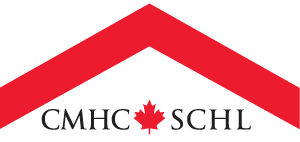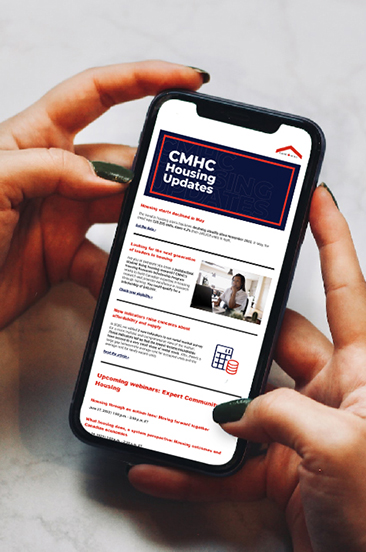(Visual: Logos of the National Housing Strategy, the Government of Canada
and Canada Mortgage and Housing Corporation are displayed side by side on a
white background. The former two logos fade out, followed by the CMHC logo
moving toward the centre and filling up the screen in an animated transition
to the first slide of the presentation.)
0:00:02
(Visual: Presentation slide featuring yellow titles on the left side of the
screen, against a dark blue background. In the centre is a wide-angle
photograph of a building under construction, with a crane against a partly
cloudy sky, three workers wearing helmets and security vests and piles of
wood planks. On the right side of the screen is a photograph of a man and
woman perusing a building blueprint on a picnic table, with pine trees and
an excavator in the background. Small logos of the National Housing
Strategy, the Government of Canada and Canada Mortgage and Housing
Corporation appear in a banner on the lower portion of the screen, against a
white background.)
On-screen text:
Federal Community Housing Initiative
Module 1: Program Overview
NARRATOR:
Welcome to our first video module. This module will provide a program overview
of the Federal Community Housing Initiative.
0:00:10
(Visual: Presentation slide featuring yellow titles in the left portion of
the screen, in larger characters, and white text in the right portion,
against a dark blue background. A small yellow box bearing the title
“The National Housing Strategy” appears in a white banner on the
top portion of the screen, against a white background.)
On-screen text:
What is the Federal Community Housing Initiative?
The Federal Community Housing Initiative (FCHI) is $618.2 million fund
designed to support community housing projects reaching the end of their
operating agreements from past social and affordable housing programs.
The initiative has two phases:
- Phase 1, which ran from 2018 to 2020; and
-
Phase 2, which started in 2020 and continues until March 31, 2028.
NARRATOR:
The Federal Community Housing Initiative is a $618 million fund designed to
support community housing projects reaching the end of their operating
agreements from past social and affordable housing programs. The initiative
has two phases. Phase 1 provided $38 million in federal funding over a
two-year period, from 2018 to 2020. Phase 2 provides $580 million in funding
for housing providers whose agreements have expired or will expire by March
31, 2028. These modules will provide an overview of Phase 2 of the Federal
Community Housing Initiative, referred to as FCHI-2. Phase 2 has two funding
streams: rental assistance and transitional funding. For our first series of
video modules, we’re going to focus on the rental assistance stream.
0:01:11
(Visual: Presentation slide featuring yellow titles in the left portion of
the screen, in larger characters, and white text in the right portion,
against a dark blue background. A small yellow box bearing the title
“The National Housing Strategy” appears in a white banner on the
top portion of the screen, against a white background.)
On-screen text:
Are You an Eligible Housing Provider?
There are two general rules to be an eligible FCHI-2 housing provider:
-
Be a housing provider whose federal operating agreement with CMHC has
expired or will expire before March 21, 2028; and
-
Be a provider whose operating agreement with CMHC is under one of the
eligible social housing programs. Please refer to the FCHI-2 Reference
Guide, under Resources, for a list of eligible programs.
NARRATOR:
There are two general rules to be an eligible FCHI-2 housing provider: be a
housing provider whose federal operating agreement with CMHC has expired or
will expire before March 31, 2028, and be a provider whose operating agreement
with CMHC is under one of the eligible social housing programs. Please refer
to the FCHI-2 Reference Guide for the list of eligible programs. Eligible
providers will receive an invitation from CMHC at least six months before the
end of their agreement.
0:01:50
(Visual: Presentation slide featuring yellow titles in the left portion of
the screen, in larger characters, and white text in the right portion,
against a dark blue background. A small yellow box bearing the title
“The National Housing Strategy” appears in a white banner on the
top portion of the screen, against a white background.)
On-screen text:
What is Rental Assistance?
Rental assistance is available to housing providers who have low-income
tenants.
It aims to fund the gap between 30% of an assisted household’s gross
monthly income and the occupancy charge (also known as rent).
NARRATOR:
Rental assistance is financial assistance intended for low-income households.
To receive rental assistance, a household must be in housing need. This
usually means that the household must spend more than 30% of its gross income
on housing. The goal of rental assistance is to help ensure that households
don’t spend more than 30% of their gross income on housing.
0:02:15
(Visual: Presentation slide featuring yellow titles in the left portion of
the screen, in larger characters, and white text in the right portion,
against a dark blue background. A small yellow box bearing the title
“The National Housing Strategy” appears in a white banner on the
top portion of the screen, against a white background.)
On-screen text:
How to Calculate Rental Assistance under FCHI-2
-
A household has a monthly income of $1,800 and a rent of $750.
- 30% of their monthly income ($1,800) would be $540.
- Rental assistance = Rent ($750) minus 30% of income ($540).
-
In this example, $210 in rental assistance would be provided.
For more information on rental assistance calculations, please refer to the
Rental Assistance Calculation Worksheet module.
NARRATOR:
The following is an example of how to calculate rental assistance under
FCHI-2. In this example, a household has a monthly income of $1,800 and a
rent, also known as the full occupancy charge, of $750. As their monthly
income is $1,800, 30% of this would be $540. To calculate the amount of rental
assistance this household is eligible to receive, you would subtract 30% of
their income, which in this case is $540, from their rent, which is $750. The
amount of rental assistance that would be provided is $210. However, the
calculation parameters also include certain additional considerations,
including but not limited to the minimum occupant charge, adjustments for
utilities included in the lease and overhousing charge. For more information
on rental assistance calculations, please refer to the Rental Assistance
Calculation Worksheet module. Please note: Households receiving similar
support or rental assistance from any other source, including municipal,
provincial or federal initiatives, are ineligible for rental assistance
through this program. It is the responsibility of housing providers, as well
as households, to choose the most beneficial rental assistance option
available to them.
0:03:45
(Visual: Presentation slide featuring yellow titles in the left portion of
the screen, in larger characters, and white text in the right portion,
against a dark blue background. A small yellow box bearing the title
“The National Housing Strategy” appears in a white banner on the
top portion of the screen, against a white background.)
On-screen text:
How the Process Works?
-
The housing provider identifies households in need and submits an
enrolment form.
-
CMHC determines the amount of annual funding and provides monthly
payments.
- The housing provider applies the funding to households.
-
Each year, the housing provider submits documentation to CMHC or the
Agency for Co-operative Housing (the Agency).
-
CMHC or the Agency reconciles the assistance paid and used according to
the program guidelines.
NARRATOR:
How the process works: An eligible housing provider identifies the rental
assistance needs of its low-income households. The housing provider completes
the FCHI-2 enrolment form and submits it to CMHC. CMHC then verifies the
eligibility of the housing provider and determines the amount of annual
funding, based on the information submitted. An agreement is signed between
CMHC and the housing provider, specifying the amount of funding and the number
of households receiving rental assistance during the agreement. CMHC provides
rental assistance payments from the effective date of the agreement and,
starting on the effective date of the agreement, the housing provider applies
the funding to rents of low-income households assisted under the agreement.
Each year, the housing provider must submit to CMHC or its representative, the
Agency for Co-operative Housing, the Agency, all mandatory documentation,
including audited financial statements and an annual report on the use of
rental assistance. CMHC or its representative reconciles the assistance paid
and used according to the program guidelines.
0:05:00
(Visual: Presentation slide featuring yellow titles in the left portion of
the screen, in larger characters, and white text in the right portion,
against a dark blue background. A hyperlink appears in dark blue characters
within the white text. A small yellow box bearing the title “The
National Housing Strategy” appears in a white banner on the top
portion of the screen, against a white background.)
On-screen text:
What Happens if My Needs Change?
Because needs change, it may be possible to amend the amount of funding
provided monthly or change the number of assisted households.
For more information, please contact the FCHI-2 team
(fchi2-iflc2@cmhc.ca).
NARRATOR:
Knowing that the needs of assisted households can vary over time, the
agreement under certain conditions may be amended to establish a new amount of
funding and/or change the number of assisted households. This is just an
overview of how the program works. For more information on the conditions and
requirements of each step, please refer to the FCHI-2 Reference Guide and the
other available modules.
0:05:27
(Visual: Presentation slide featuring yellow titles in the left portion of
the screen, in larger characters, and white text in the right portion,
against a dark blue background. Two hyperlinks appear in dark blue
characters within the white text. A small yellow box bearing the title
“The National Housing Strategy” appears in a white banner on the
top portion of the screen, against a white background.)
On-screen text:
Who to Contact for More Information about Program Administration
There are resources available to support the administration of FCHI-2,
including tools for calculating rental assistance.
NARRATOR:
CMHC and the Agency have resources to help housing providers with the
administration of programs, including tools for calculating rental assistance.
For more information about program administration for co-operatives
administered by the Agency, please email
info@agency.coop. For housing providers
administered by CMHC, please email
ge-am.adm@cmhc.ca. Additional
information is also available on the website.
0:06:03
(Visual: Presentation slide featuring yellow titles in the left portion of
the screen, in larger characters, and white text in the right portion,
against a dark blue background. A small yellow box bearing the title
“The National Housing Strategy” appears in a white banner on the
top portion of the screen, against a white background.)
On-screen text:
What Else Do You Need to Know?
This is just an overview of how the program works.
For more information on the conditions and requirements of each step,
please refer to the FCHI-2 Reference Guide and other available modules.
NARRATOR:
This is just an overview of how the program works. For more information on the
conditions and requirements of each step, please refer to the FCHI-2 Reference
Guide and other available modules.
0:06:16
(Visual: Presentation slide featuring yellow text in the centre of the
screen against a dark blue background. Small-sized logos of the National
Housing Strategy, the Government of Canada and Canada Mortgage and Housing
Corporation appear in a banner on the lower portion of the screen, against a
white background. The screen collapses within the CMHC logo, in an animated
transition to a white background. The CMHC logo moves to the right side of
the frame, and the National Housing Strategy and Government of Canada logos
fade in on the left side and centre of the screen.)
On-screen text:
Thank you!
NARRATOR:
Thank you.







 Share via Email
Share via Email

